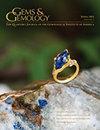Geographic Origin Determination of Alexandrite
IF 1.6
3区 地球科学
Q2 MINERALOGY
引用次数: 3
Abstract
GEMS & GEMOLOGY WINTER 2019 A fter the discovery of a gem mineral with unusual color-change behavior in the Russian Ural Mountains during the early 1830s, Swedish mineralogist Nils Adolf Erik Nordenskiöld named this new gem alexandrite in 1834 in honor of the future Czar Alexander II (Kozlov, 2005). This immediately created a royal and romantic aura around this variety of chrysoberyl. The most coveted alexandrites exhibit a lush green to greenish blue color in daylight and a warm, bright red shade in candlelight (Levine, 2008); some fine Brazilian and Indian alexandrite examples are shown in figures 1–3 and 6. This phenomenal color change is caused by the presence of trace Cr3+ substituting for Al3+ in the chrysoberyl crystal structure. Alexandrite is routinely described as “emerald by day, ruby by night.” It is a stone of duality—green or red, cool or warm, day or night (Levine, 2008). Because of its rare and attractive color-change phenomenon, alexandrite has been highly sought after and is one of the most valuable gemstones in the trade. Alexandrite, particularly fine-quality material, is also very scarce; it has generally been a byproduct of mining other major colored stones. Overall production statistics are hard to evaluate. It has been mined in Russia (Kozlov, 2005; Schmetzer, 2010), Tanzania亚历山大岩的地理成因测定
2019年冬季宝石与宝石19世纪30年代初,瑞典矿物学家尼尔斯·阿道夫·埃里克·诺登斯基在俄罗斯乌拉尔山脉发现了一种具有异常变色行为的宝石矿物,1834年,为了纪念未来的沙皇亚历山大二世,他将这颗新宝石命名为亚历山大岩(Kozlov,2005)。这立刻在各种各样的金绿宝石周围创造了一种皇家和浪漫的氛围。最令人垂涎的亚历山大岩在白天呈现出郁郁葱葱的绿色到绿蓝色,在烛光下呈现出温暖明亮的红色(Levine,2008);一些精美的巴西和印度亚历山大岩实例如图1-3和图6所示。这种显著的颜色变化是由金绿宝石晶体结构中微量Cr3+取代Al3+引起的。亚历山大岩通常被描述为“白天的祖母绿,晚上的红宝石”。它是一种具有双重性的石头——绿色或红色,凉爽或温暖,白天或夜晚(Levine,2008)。亚历山大石因其罕见且引人注目的变色现象而备受追捧,是业内最有价值的宝石之一。亚历山大岩,特别是优质材料,也非常稀缺;它通常是开采其他主要有色石头的副产品。总体生产统计数据难以评估。俄罗斯(Kozlov,2005年;Schmetzer,2010年)和坦桑尼亚都有开采
本文章由计算机程序翻译,如有差异,请以英文原文为准。
求助全文
约1分钟内获得全文
求助全文
来源期刊

Gems & Gemology
地学-矿物学
CiteScore
2.90
自引率
19.20%
发文量
10
期刊介绍:
G&G publishes original articles on gem materials and research in gemology and related fields. Manuscript topics include, but are not limited to:
Laboratory or field research;
Comprehensive reviews of important topics in the field;
Synthetics, imitations, and treatments;
Trade issues;
Recent discoveries or developments in gemology and related fields (e.g., new instruments or identification techniques, gem minerals for the collector, and lapidary techniques);
Descriptions of notable gem materials and localities;
Jewelry manufacturing arts, historical jewelry, and museum exhibits.
 求助内容:
求助内容: 应助结果提醒方式:
应助结果提醒方式:


